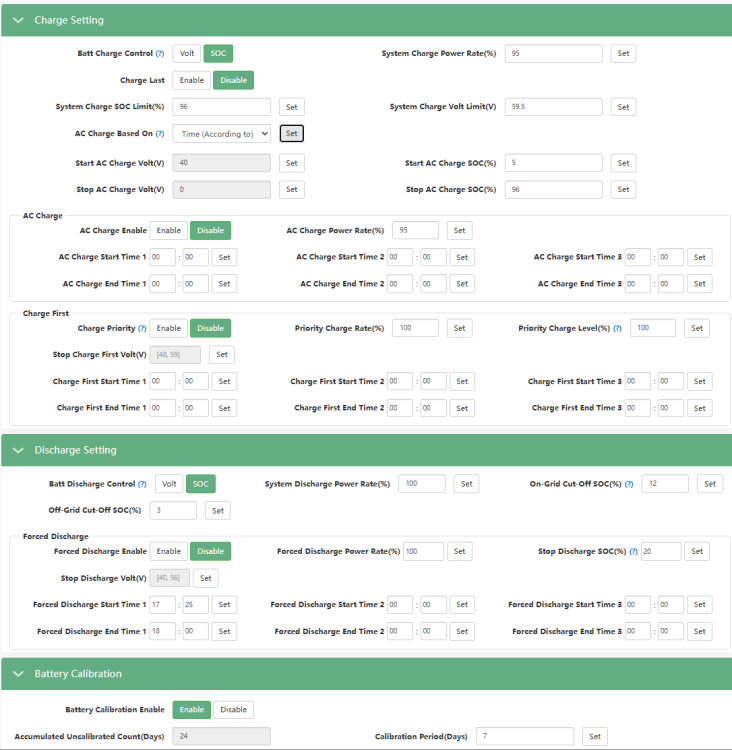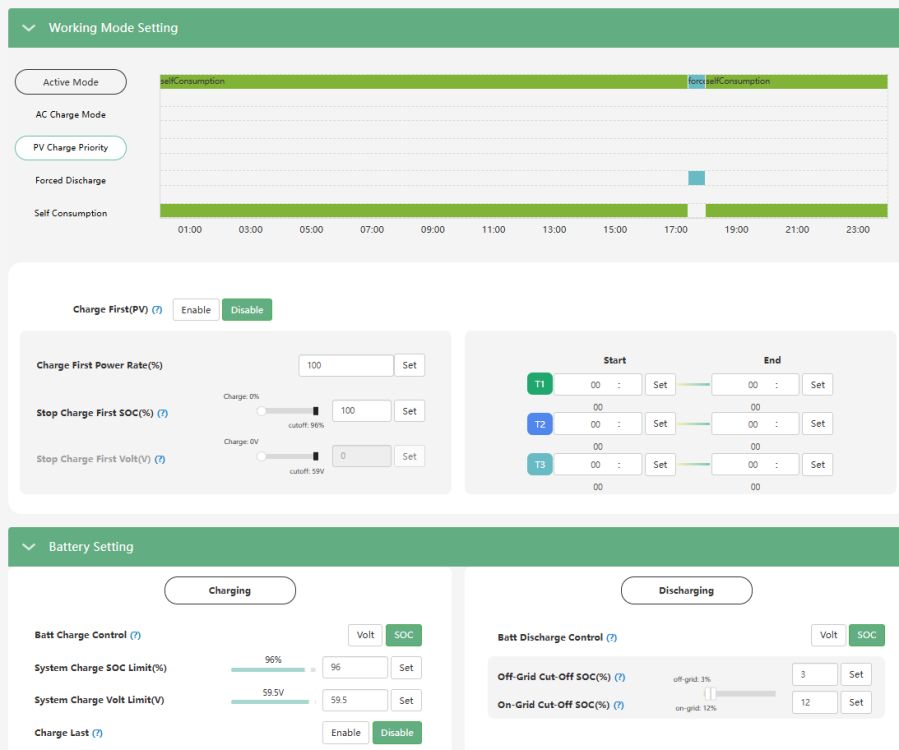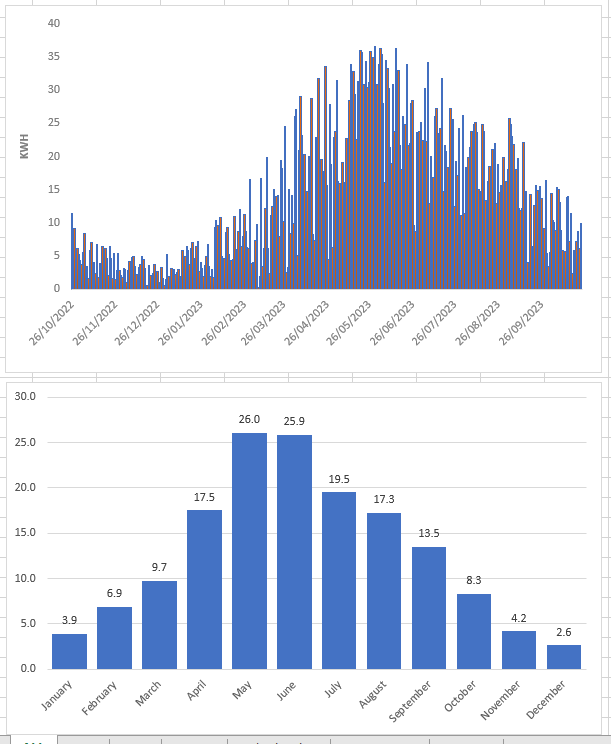
MrTWales
Members-
Posts
194 -
Joined
-
Last visited
Everything posted by MrTWales
-
Just to add, in case anyone else has this issue - the system was apparently trying to charge at 00:00 due to battery callibration, where it tries to charge to 100% but couldn't as the limit is set to 96% so it kept trying. I never changed any settings but it looks like if you click on the "enable" to calibrate then you need to change the SOC charge limit to 100% until it's gone through one cycle.
-
Hi, I have a Luxpower Hybrid Inverter 6K [LXP-6K Hybrid] and it's been working properly for a couple of years but recently it's not been working as it should. I'm going through the support email address and they are getting back with the odd thing, but once they updated the firmware it's got even worse. They've not got back for a couple of days so I'm just seeing if I can find a way to get the damn thing to work. The webpage interface has changed recently so I guess the issues may be related to this but it's been hopeless. The recent issues are: - using time slots and SOC to charge no longer works. Apparently this is a design issue but it used to work. Now you have to set the charge at night for period, or else set the system to charge when the battery SOC reduces to a certain level. So, for example, you can't now charge the battery to 30% at 4am-5am. It's a bit crap but hopefully it will change. - the forced discharge stopped working, but now it is. - the battery isn't used at 00:00 no matter what the battery SOC is. I've gone through every setting and can't for the life of me see any setting that should even lead to this happening (the battery isn't charging at 00:00, it's just not used). - Luxpower updated the firmware but now it's even worse! At 00:00 the battery gets changed at the max level. This is even when AC charge is disabled and all time slots are 00:00 (ie nothing is even set). - all I can do is set the overall battery max charge level to something small at night, and then change it back in the morning so the solar charges the battery. This stops the battery charging but the battery still isn't used at 00:00. If anyone can suggest something that I could try it would be appreciated! I've pasted the main settings, both the new and old look options.
-
Thanks, that is interesting. There is another setting elsewhere where the battery is stopped from going below a certain point (6% or thereabouts) and this setting is only in the charge section. At the moment it shows a zero but this is out of range so I guess it's assuming the default, whatever that is.
-
I really have tried to find out but there is nothing in the manual, or any similar manual online - though many have a similar page to the page below but without this parameter. I get what "System Charge Power Rate(%)" is, though is there any reason it's bad to put in 100%? Looking looking online most of the time it's 80% or something like that. I'm not sure if this overrides the "AC Charge Power Rate(%)" parameter but I'll just set them as being the same. I get what "Stop AC Charge SOC(%)" means, even I can understand that! But what is "System Charge SOC Limit(%)"? If the page isn't loaded up then it wants a [10,101] range but it doesn't like anything if I put a figure in and press "set". I think I changed this recently, thinking it was the previous field by mistake, so I don't know what it was previously set as and I can't seem to set everything to default either. My inverter is called LXP Hybrid Inverter 6K [LXP-6K Hybrid]. Any clues would be appreciated!
-
Ah thanks for this. I wasn't aware of this - I thought that you could have Flux Export only with Flux Import, but I wasn't aware of any other options. When I can face it I'll think it through and get it sorted. My inverter has a fair number of options but not quite as many as I'd like, but I can set several windows to imports / push to the grid.
-
I'm one day shy of a full year with panels and it's amazing how generation varies. Not just by month but by day. I know it's kind of obvious but one day can be three times the previous day very easily. My system is 12*410w panels at only 10 degrees on a flat roof, so bad for winter but it was an easy install and I can clean myself etc. The chart shows the amazing May and crappy July/August that we had!
-
Oww...I'm on Flux but it looks like I should be thinking about Cosy. What I'm worried about is judging how much to charge the battery. If it gets full in the day then I'm at least getting an export amount paid now, but this stops with Cosy? I guess it's less of an issue each day and you can top up to a certain figure before the high import rates start.
-
As others have said, shading is a big issue potentially and another is weight. The usual fitting method with a flat roof I believe is ballast, so they add concrete to the fixing brackets. With the panels maybe being 20kg each that's a lot of weight so the rafters need to be strong enough.
-
No worries - at the moment my usage charge is a decent credit, but in the winter I may be better off with a different tariff. I suspect the best ones for those with a decent sized battery will require an EV.
-
What are the export rates? I don't have an EV so I'm not sure it's an option for me though anyway.
-
Well, being on this tariff certainly makes things interesting. As far as I can see I can't change the priority discharge ordering in the inverter settings (to using the battery first) in the evening Flux period of 4pm to 7pm, but I can force a battery discharge. But if I discharge at 25% say, which is 1kw in my case, then it just pushes this much out and won't increase if the load is higher. If I discharge at 100% then the export is 4kw + solar - useage, which can be loads. The downside is potentially depleting the battery and having to import at the highest rate. It seems to me that the best solution is to ignore the first part of the Flux period and set the discharge from something like 6pm to be 100% with a cut off whereby the battery doesn't get below a certain point. The latter is just because it may mean importing at the heighest rate if the battery runs out, but not leaving much battery at 7pm isn't a disaster as the Flux export rate is probably very close to the standard import once effeciency has been factored in. There then is the Flux period from 2am to 5am. After efficiency it seems like importing then and exporting at the standard rate is virtually break even, maybe a tiny gain. So there is probably merit to just fully charging the battery in this period. I think I'll not bother recharging when the weather is good as the battery will get to 100% before 4pm on most summer days, but otherwise charge to a specific percentage figure.
-
Advice please: solar diverter install
MrTWales replied to crispy_wafer's topic in Photovoltaics (PV)
I take there is no gas installed? If so and you can get on something like the Octopus Flux tariff then it's cheaper to use gas for water than to reduce the export. Fwiw I had a water diverter installed way after the main installation (they just ran out of time on the day) and it was maybe 90 mins or so to install if not less when they finally came back. It looked simple for any electrician to be honest. -
Just to update this - I am now on the Flux Export Tariff. For anyone doing through this process, it's worth calling Octopus if there are any delays. Eg the MSC cert had the wrong MPAN code so I had to get the installer to change this and send it on (it wasn't their fault fwiw), and when I called Octopus after a few days to make sure they had it it was just sat there but the moment I called it got forwarded on. Also, when the export was set up it it showed incorrectly in the app (as if it was an import on the variable tariff) but a quick call got it flagged correctly. So now I can see that I exported 19.1 kWh yesterday (being on holiday now!), compared to 19.4 kWh as per the inverter app. So that seems pretty good, with £3.93 credit.
-
I think my smart meter is different, it just has up and down buttons. I've checked the G99 letter and it mentions something or other about max export but doesn't have any reference to a MPAN so I guess I'll have to wait. Mind you, the weather forecase is pretty crappy so at least I can use any excess for the water.
-
Thanks, looks like 10-14 days and I better put the immersion diverter back on!
-
Edit - I think I'm on Flux Import so I can't export yet, I assume anyway. Hopefully not for long!
-
Update - I am on Flux! I won't break open any champagne until I see exports working (I can't see how this shows in the app) but the process was very quick. I had a smart meter install on Wednesday (via Shell, or a contracttor should I say) I called Octopus on Thursday to switch. They said I'd be on the variable tarrif (which was the same rates as Shell, but for the standing charge which is a bit lower) and needed to apply to Flux, but it could take 6 weeks as they need to test that they could communicate with the smart meter etc. I applied on Friday for Flux, which meant ticking some boxes and providing a G99 letter (to show DNO approval) and the MCS cert number (which they look up and tie to the property). Now, two says later, they say that I'm Flux. So, I'm very impressed so far - even without being on Flux the app is very good, with usage data easily seen for electric and gas. Fingers crossed that the export works properly.
-
This is what I've just got from Shell. I guess there is some change in wholesale costs or something from 1 July. Your electricity rates are changing from 33.282p to 30.222p per kWh. Your electricity standing charge per day will remain the same at 53.82p. Your gas rates are changing from 10.467p per kWh to 7.664p per kWh. Your gas standing charge per day will remain the same at 29.11p.
-
This is why phrases like "utility" are used when trying to model decisions etc. Most people would rather £1m with certainty than £2.1m with probability 50%, as this would likely maximise their happiness even though the decision to take the £1m loses £50k in value. My 65 inch TV absolutely pays for itself in happiness units, as does the doughnut I'm about to eat!
-
This guy has it sorted! Personally, I'm happy with a mug of Early Grey tea and a Lidl chocky doughnut and the smug smile you only get from having an oversized solar system. Oh my god I need to go out and get some of these!
-
If a smaller battery provides a better return then it doesn't mean that a bigger battery is a bad investment - even if you are purely looking at the expected value. The extra spend may still be better than the alternative investment. I also hope that people try to maximise happiness and not focus on the pure financial side whereever possible, though this is of course correlated. We all do this every day! As long as people aren't missled then it's all good imo.
-
I'm trying to maxmise happiness and the extra cost, in terms of actual pounds, means nothing to me quite honestly. I wanted to maximise generation on the specific roof and there is nothing irrational about this. However, I'm fairly sure that I could find a set of assumptions that would make the install close to optimal (as an actuary I can usually find assumtions to say what I want, but I won't go there). In terms of the panels, the marginal cost wasn't that great. It's just one flat roof with four rows of three and it looks great. If I'm getting anything half sensible for importing then it may be close to optimal anyway. Like I say though, I like getting what I can from the roof. Heck, don't we all spend time faffing about with calcs when the value barely justifies it? It's fun, right? The battery is a different thing I guess, and initially I didn't think that a large battery made any financial sense but the main thing putting me off was the size. When I saw how small the ones I have are then I got the larger option, and it wasn't as expensive as I thought. I didn't actually have as much choice in terms of parts as I'd like, without a wait, as parts were so scare last summer. I approached over 20 firms, put my details on sites like Bark, and hardly got anything back. They even used a larger hybrid inverter (for no extra cost) as they couldn't source the smaller one they costed for. As it happens, the quote I went with was the lowest despite having a bigger battery. As it is, it's big enough to last a day so charging at night means it's of value in the winter. Yes any saving, if there is one, is lower per pound of instal cost than a smaller battery but I really don't care! Back to TVs - if I consider a 20 year period, for example, then what I spend on TVs/soundbars etc over the cheapest options (second hand, smaller etc) will add up to plenty. It's still great value to me though!
-
Just to be clear, when you are with Octopus you can change tarrif without penalty? That's what they told me anyway. I have no idea what works best for winter, but Flux is way better than what I'm on now and I feel like I can manage things fairly well. It's also way better than what I'm on now for winter but it sounds like there may be better options, though of course all tarrifs can be changed or removed.






